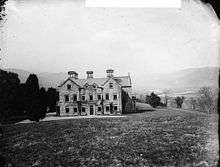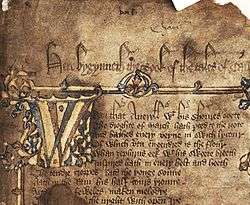Hengwrt
Hengwrt (English: Old Court) was a mansion near Dolgellau in Meirionnydd, Gwynedd. It lay in the parish of Llanelltyd near the confluence of the River Mawddach and River Wnion, near Cymer Abbey.


History
Hengwrt was recorded as a grange of Cymer Abbey, and after the Dissolution of the Monasteries passed with the rest of the abbey properties to Sergeant at Arms John Powys. It was eventually bought by Hywel Vaughan of Gwengraig, after which it remained in the Vaughan family for many years.[1]
A new house was built in 1750-54 on the site of the earlier building; it was substantially remodelled in 1830, when it was refaced in stone.[2]
Hengwrt was purchased by William McConnel in 1859. McConnell was the owner the Sedgwick cotton mill in Manchester, one of the largest mills in operation in the United Kingdom. In January 1864, he formed the Aberdovey Slate Company which leased the Bryn Eglwys slate quarry near Abergynolwyn. He built and opened the Talyllyn Railway to transport slate from his quarry to the main line at Tywyn; he owned the railway and quarry until 1910.[3]
Hengwrt mansion was demolished in 1962 following a fire, though some of its outbuildings survive.[2]
Literary connections
It is famous in Welsh literary history as home of one of the most important collections of Welsh manuscripts. These manuscripts came into the possession of the collector and antiquarian Robert Vaughan, who lived at Hengwrt during the 17th century. They included treasures such as the White Book of Rhydderch, Black Book of Carmarthen, Book of Taliesin and the Book of Aneirin, along with the Brut y Tywysogion. The collection includes an important early copy of Chaucer also known as the "Hengwrt Chaucer" or, misleadingly, the "Hengwrt Manuscript".
These manuscripts remained safe in the Hengwrt library for 300 years, although several others in the collection (including the Hendregadredd Manuscript and the lost Hengwrt 33 or Hanesyn Hên) disappeared in the late 18th century.[4] Edward Lhuyd is recorded as having seen the antiquarian books there in 1696. A number of 18th and early 19th century antiquarians visited the mansion to see and copy manuscripts, including Evan Evans, William Owen Pughe and Iolo Morganwg. The library was inherited by William Watkin Edward Wynne of Peniarth in 1859, and subsequently John Williams purchased the library and donated it to the new National Library of Wales in Aberystwyth.
The room in which the manuscripts are displayed today is named "Hengwrt", after the mansion.
In the 18th century Hengwrt was the home of the diarist Elizabeth Baker.
In the late 19th century it was the home of sculptor Mary Lloyd and her partner, the journalist and social reformer Frances Power Cobbe.[5]
References
- Dolgellau Character Area 5 Archived 2016-08-18 at the Wayback Machine, Gwynedd Archaeological Trust
- Hengwrt House, COFLEIN
- Rolt, L.T.C. (1965). Talyllyn Century: The Talyllyn Railway, 1865-1965. David & Charles.
- Guy, R. "A Lost Medieval Manuscript from North Wales: Hengwrt 33", Studia Celtica L (2016), 75.
- Mitchell, Sally (2004). Frances Power Cobbe: Victorian Feminist, Journalist, Reformer. University of Virginia Press. pp. 144, 335.
External links
- "Hengwrt Chaucer" on the National Library of Wales website